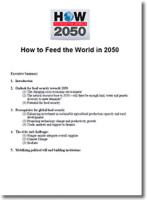How to Feed the World in 2050
While agriculture will be forced to compete for land and water with sprawling urban settlements, it will also be required to serve on other major fronts.
The prospects for agriculture
In the first half of this century, as the world’s population grows to around 9 billion, global demand for food, feed and fibre will nearly double while, increasingly, crops may also be used for bioenergy and other industrial purposes.
New and traditional demand for agricultural produce will thus put growing pressure on already scarce agricultural resources.
And while agriculture will be forced to compete for land and water with sprawling urban settlements, it will also be required to serve on other major fronts: adapting to and contributing to the mitigation of climate change, helping preserve natural habitats, protecting endangered species and maintaining a high level of biodiversity.
As though this were not challenging enough, in most regions fewer people will be living in rural areas and even fewer will be farmers. They will need new technologies to grow more from less land, with fewer hands.
The problems to be resolved
- Will we be able to produce enough food at affordable prices or will rising food prices drive more of the world’s population into poverty and hunger?
- How much spare capacity in terms of land and water do we have to feed the world in 2050?
- What are the new technologies that can help us use scarce resources more efficiently, increase and stabilize crop and livestock yields?
- Are we investing enough in research and development for breakthroughs to be available in time?
- Will new technologies be available to the people who will need them most - the poor?
- How much do we need to invest in order to help agriculture adapt to climate change, and how much can agriculture contribute to mitigating extreme weather events?
What’s Related


Favorites





